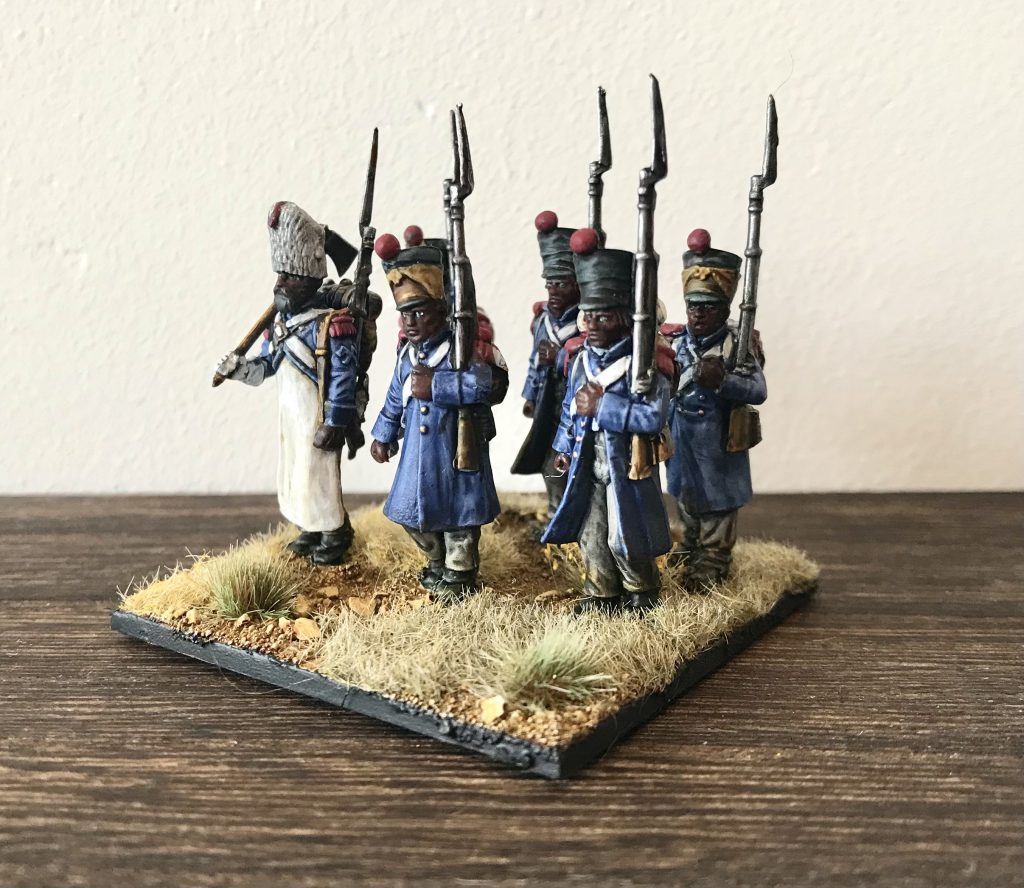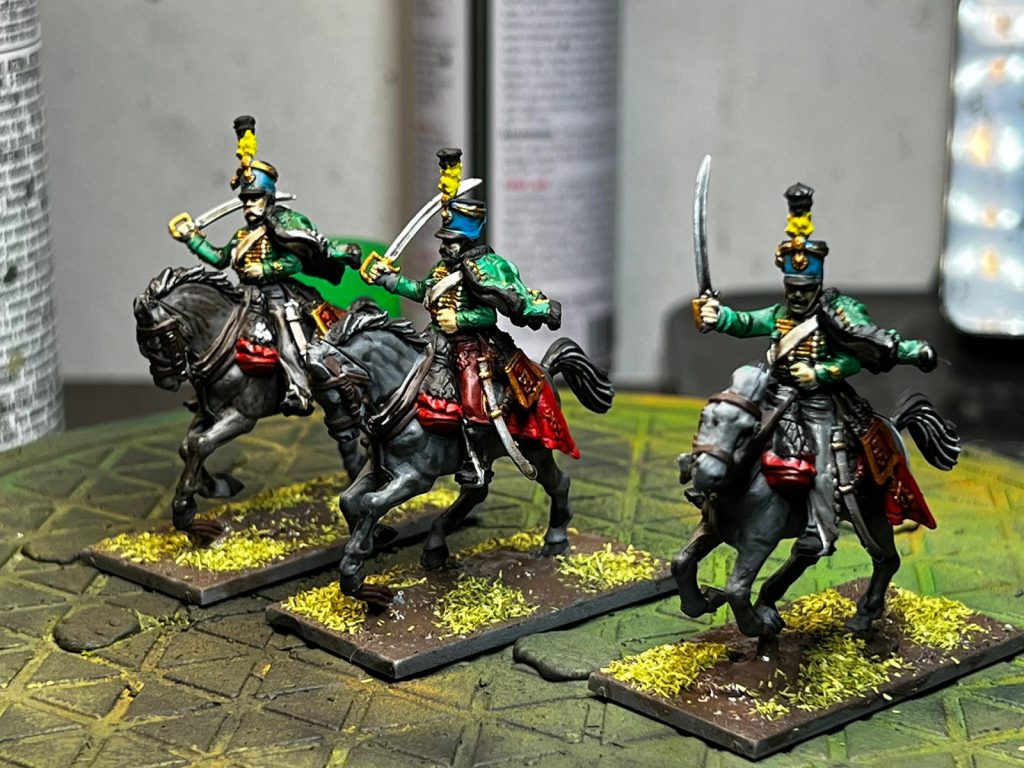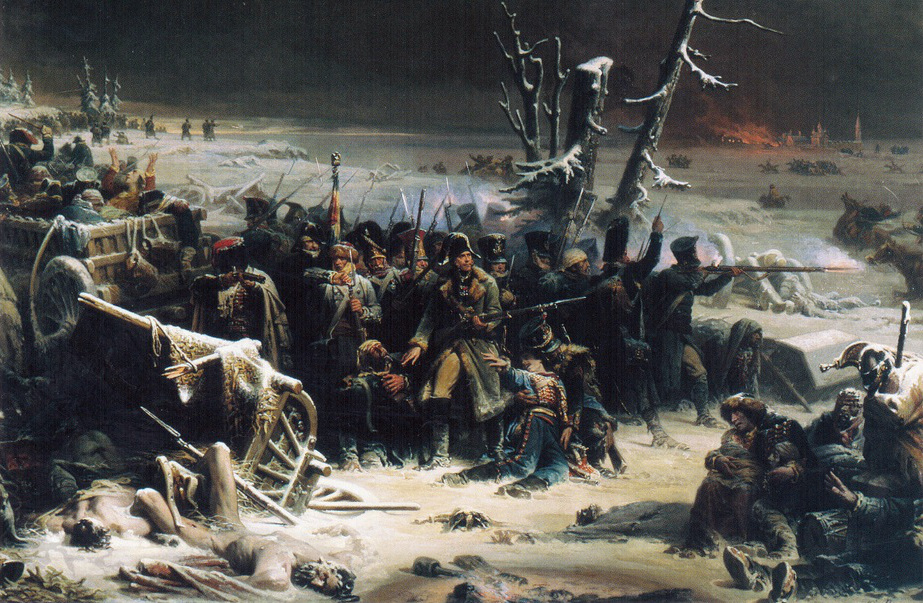Hello, folks! Enzo again, with a rather tardy column from my efforts to crush the revolutionary pretender in Paris.
Napoleonic gaming is the first thing that comes to mind for many when they picture historical tabletop games. If you’re interested in historical wargaming, you’ll probably at least look into the Napoleonic Wars. If your local club or store has a historical group, a few folks there have probably gamed out Waterloo. There are quite possibly countless rulesets for the era across the various miniature scales and battle sizes. We here at Goonhammer Headquarters love Sharpe Practice, a TooFatLardies skirmish system that plays for all black powder-era conflicts (1700–1865 on the cover), but the core rules are named after and centered around the Sharpe’s Rifles series.

Before you take up the sabre and paint your regiments with the EXACT* correct coat and buttons, you have to take up the rather daunting task of picking your faction. Unlike a scifi or fantasy game where you’ll be looking at a massive variety in models for monsters, robots, wizards, spacecraft, or even dramatically different infantry choices, this is a game about infantry, horse, and artillery. You’re choices are more narrowly defined by uniforms (and this relies on well-sculpted models), colors, and factional military history. So, here’s my hot takes on helping you pick an army in the Era of Napoleon.
A couple quick asides: I’m not a 19th century historian, so my reading recommendations are more for narrative accounts and historical fiction. We’d love to hear back from readers about their own recommendations! Also, for ease of discussing availability of models, this is going to focus on 28mm games based around land wars. One of the terrific things about the era is the wildly colorful and decorated uniforms, and each of these armies had a truly fantastic wardrobe. I personally hold that 28mm is the best scale to get into Napoleonics, because it gives you miniatures that can best capture that. The sacrifice is that your battles will have far greater abstraction of model count to troop count.
Today, we’ll be going over the Big Five of Napoleonic Wars belligerents: the French (duh), the British, the Austrians, the Russians, and the Prussians. Next, we’ll look at equally important but less ‘famous’ factions, such as Spanish guerillas and the forces of various non-Prussian German States.
This list also doesn’t cover the fantastic options for naval hobbying and wargaming, but we’ll be targeting that soon. In the mean time, just watch Master and Commander.
French Empire

I mean, this is pretty obvious, right? It’s called the Napoleonic Wars, someone has to play the armies of Napoleon. I’ll admit that there’s plenty of fine alternative histories or other scenarios you and your crew could come up with, but c’mon. Someone has to play Bonnie’s troops.
If you plan to supplement your play with reading and research (I assume you will, you nerd), the only issue with studying Revolutionary France or the First French Empire is just how much material is out there.
Hobbying: There’s a good deal of variety in Republican and Imperial French armies, but for the most part, you’re going to be painting lots of blue coats and white pants. There’s a massive variety of models, maybe beaten by the British. You’ll also have access to a wide source of great plastic across infantry, cavalry, and artillery. Some of the more unique cavalry, including hussars and lancers. But more on that…
Immediately. I’m not going to try to list out all of the client states of the French Empire (there’s about 40), but this diversity in forces that you can represent on the table top. Polish lancers of the recruited Duchy of Warsaw are one of the more distinguished units for the era. Bavaria and other members of the Confederation of the Rhine served alongside the French from 1806 to 1813, seeing action in most of the major campaigns of the area. As a collector, this allows you a great variety of “palate cleansing” options to paint up, and a unique allied unit to put on the tabletop. As a bonus, many of these client states turned on Napoleon, giving you an opposition force depending which era you want to play.
Hobbying and Collecting: It’s safe to say that collecting the French gives you the most options for miniatures, with Perry and Victrix taking the lead. These manufacturers also have some of the more famous units—the Imperial Guard, the Polish Lancers—in plastic, where other factions have to collect their unique units in metal.
Reading, Watching, Listening: The historical analysis of Napoleon himself is split between two coalitions: historians who admire Napoleon as a commander and an enemy of Europe’s monarchies, and those who despise him as a vicious warlord. There’s too much content out there for me to make academic recommendations. I’d recommend Bernard Cromwell’s Waterloo for a narrative history of the battle. If you have time for an epic, the 1970 film Waterloo has a great cast and truly magnificent cinematic imagery.
Bonus: You get to sing “La Marseillaise” at the top of your lungs during deployment.
United Kingdom

Again, do I have to say it? Who beat the Guard back at Waterloo? If this isn’t the faction that’s most famous, it’s perhaps the most iconic. For many Americans wanting to play Napoleonics, this is the red versus blue team set up.
Playing the red coats opens one up to playing some of the most interesting and far flung episodes of the wars. You can recreate the amphibious landings at Abukir. You can send your forces to the Cape of Good Hope to drive out the Dutch. You can, of course, fight the Irish.
And, of course, you can relitigate Waterloo on the tabletop with your friends. Again. And again. And again. Bernard Cromnwell said it may be history’s most analyzed battle, and he could very much be correct. I’ll copy his logic that it is the most important battle of the Napoleonic wars because it is the battle that ended the Napoleonic wars.
Hobby and Collecting: Baal Red Contrast is a pretty great paint, ya know? The British army’s distinct red coats make up a great deal of their infantry and cavalry uniform, and if you like that look, you’ll love painting up some Brits and pushing them up the table. It’s a force that distinguishes itself with its uniformity. Also, you get to play the winners, so that’s fun.
Some distinct forces to consider: Scottish Highlanders in kilts, and you have to paint a unique tartan on each one. Also, you can add Portuguese and Spanish royalist forces, as well as Spanish guerillas, to your allied troops.
Reading, Watching, Listening: I’ll lead off with my own recommendation: the Sharpe’s Rifles series. It’s available on Amazon Prime Video with an additional BritBox subscription if you’re U.S.-based. Sean Bean plays the titular Richard Sharpe. Each episode is movie length, and each episode can be summed up as ‘how is Sharpe gonna get himself out of this one?’ It’s an action movie set in the Peninsular Campaign. I binged it effortlessly. The book series it is based on is by all accounts fantastic as well.
Bonus: DO YOU WANT TO SEE A GUILLOTINE IN PICCADILLY? DO YOU CALL THAT RAGGEDLY NAPOLEON YOUR KING? DO YOU WANT YOUR CHILDREN TO SING LA MARSEILLAISE?
Austria/Holy Roman Empire

Play them to roleplay the Great Catholic Kings of Europe. That’s it. That’s the best and only reason.
The Habsburg monarchy was Napoleon’s greatest enemy. The Archduke’s forces battled the French in Europe for twice as long as the Prussians, and almost four times longer than the British. The high command of Austria was hampered by political infighting, the army structure was weakened by regressive command and training doctrine, but the troops were fierce fighters. When his subordinates would mock the Austrians for their (many) defeats, Napoleon would later chide them with ‘clearly you weren’t at Wagram.’
Now, it’s true that the Habsburgs were most often the other belligerent in Napoleon’s great victories, from his time as general, to consul, to Emperor. When I decided to start collecting them, I realized I was playing the guys on the receiving end of the brilliance at Austerlitz and Marengo. But as much as you need someone in your club to game the French, you need someone to game the Austrians to capture either the most famous battles of the age, or to just capture the general flavor of the European campaigns.
Hobby and Collecting: Do you know why I grabbed my first Victrix bag of Austrian grenadiers? Because I wanted to challenge myself by painting an army of white uniforms. Austrian regular and grenadier infantry shined on the battlefield in beautiful white jackets and, in German regiments, white trousers, regiments noted by cuffs and turnbacks. Painting up these infantry squares takes as much courage, if not more, as marching into French guns. Collecting an Austrian force also lets you switch up your regular infantry by painting up Hungarian regiments, distinguished by light blue pants. The Austrian cavalry also stakes a claim to ‘Best Dressed on the Battlefield’ to the shining enamel breastplates of cuirassiers, or the dazzling colors of Hungarian hussars.
You can easily find Austrian-German infantry and some cavalry in Perry and Victrix plastic. Both these companies offer line infantry with pre-1809 crested helmets and post-1805 shakos, as well as bearskin cap grenadiers (see my review of the Victrix kit). Perry also sells two plastic box sets of Austrian cavalry. The generic ‘Austrian cavalry’ kit can be used to build cuirassier, dragoons, or Chevauxlegers, and then a Hussar kit lets you build up some well-dressed light cavalry. This is a pretty good star to any mass battle force, but for artillery and unique options, you’re back to looking at metal minis. Perry and Wargames Foundry are one source for Hungarian options for early (helmeted), late (shakos) and grenadier infantry. Hungarian miniatures will be distinct because the blue pants run down to the top of their shoes, where German infantry had knee-high boots. Perry makes a series of metal sculpts for ulhans, the lance-armed cavalry recruited from Eastern Europe. If any reader has found a way to convert Napoleon’s French lancers, I’d love to see it!. Distinct artillery sculpts will also be pewter kits.
Reading, Watching, Listening: There’s not a lot of representation of the Austrian army of this era in popular culture, at least not in the English-speaking world. Napoleon’s Greatest Adversary: Archduke Charles and the Austrian Army, 1792-1814 is my recommended introduction to the topic. I will caution listeners that while interesting, this is an academic book. It is a rather dry analysis of Imperial Austrian military organization and conduct. It’s full of reviews of drill manuals, quartermaster lists, and the diaries of generals. I found it insanely interesting, but I’ve spent more of my professional life than I’d like to admit reading over academic analyses of militaries.
Hobby and Collecting: Plastic Russian line infantry is available from Perry, but not Victrix, so that’s 50% of my gold standard producers covered. Perry recently released a plastic kit for Russian Uhlan lancers. I haven’t seen the kit in person to review it, but any time you can purchase plastic lancers and avoid either bendy soft metal lancers or having to drill brass rod lances into your miniatures is great. That alone is huge boon. Depending on what setting you want to paint your Russians, you may need to hunt for infantry wearing winter overcoats. Cossacks and Don Cossacks are a famous unit that you’ll definitely want to include in your collection, especially if you wish to game out harassing skirmishes against Napoleon’s fleeing forces. Here, Perry has a great variety, but they are all metal.
Russian Empire

Author’s Note: I am going to use the demonym ‘Russian’ to describe the Russian government, military, and peoples. Many distinct peoples have composed the population of historical Russia, and there’s a long and tragic history of Tsars, Bolsheviks, and the current authoritarians in Moscow either dismissing their distinction from what some consider ethnic Russians, when not wiping them out.
Two big reasons to collect the Imperial Russian army come to mind. The first is simple: 1812. Napoleon’s invasion of Russia is one of the most disastrous military campaigns in history. Better historians than me would argue that this singlehandedly doomed his own empire. La Grande Armee was essentially destroyed by December 1812. The French emperor would have to reconstitute most of his force, and even with France’s massive reserves of manpower, it’s hard to fully comprehend the loss of veteran fighters. It also shattered the myth of Napoleon’s invincibility forever.
Of course, the famous role of the Russian army in 1812 is its refusal to give battle after Borodino, leading the French on a chase that dwindled French supplies across the steppe. But, it’s a fantastic setting for skirmish games using Russian regulars, partisans, and of course the dreaded Cossack cavalry.
But beyond that specific campaign, you might find yourself wanting some Russian regiments because they were used against Napoleon throughout the wars. If you’re collecting Austrians (and you should, they’re the best), you’d be well within historical grounds to either ally in a Russian brigade. Even if you’re not using a ruleset with viable allowances for including allies, those Russian green coats are good hobby aside and they would not be out of place. Russian soldiers fought in almost every major battle on the continent. If you wish to game some alternative history, it was the Russian army that was poised to sack Paris in the lead up to both of Napoleon’s abdications.
Napoleonic Russian collectors have a number of other conflicts they can easily game out. If you know someone who collects Ottoman or Swedish forces for the era, the Russia Empire fought both at the turn of the century. I’m not aware of early 19th century Persian forces, but if you find them, first TELL ME, two, paint them up, and battle out the Russo-Persian War of 1804-1813.**
Reading, Watching, Listening: Leo Tolstoy’s War and Peace. At risk of sounding like an overeager literature, this is the book about the Patriotic War of 1812. I cannot suggest anything else in this category. It’s a beautiful piece of writing.
Prussia

Is it safe to say that the Prussians are the third most popular faction after France and Great Britain? I think so. As I’ve harped on before, Waterloo is THE battle that comes to mind for many, and the Prussian appearance one of those moments when history plays out like cinema.
If we anthropomorphize kingdoms, Prussia’s role in the Napoleonic Wars follows a powerful arch of defeat and recovery. The Prussians suffered an number of defeats and ceded considerable territory to the French, eventually finding itself forced into an alliance, even taking part of the French invasion of Russia. By the time of the French Revolutionary Wars, the army built by Frederick the Great had fallen into disrepair. The reforms of 1806 did not initially overthrow the Imperial French yoke, but it did inspire vital myths such as the rebellion of Ferdinand Baptista von Schill. The Wars of Liberation and the army’s success in the 100 Days War are legendary, and that legend played into the Prussian domination of the German states in the later half of the 19th Century. Defeat and reformation is the story you’re playing out, especially if you and your fellow wargamers use your collection to battle throughout the 1790s and early 1800s.
Hobby and Collecting: You get to use Prussian Blue paints for their original purpose! Prussian troops! There are many pigments named for a specific purpose across paint lines, but Prussia blue is part of triumvirate with Panzer Grey and U.S. Olive Drab. Prussians are a popular faction, you’ll find plenty of plastic infantry, especially the famous Landwehr. You’ll find plastic horse and cannon, but you might need to branch into metals for more unique units like lancers. Perry Miniatures has produced a lot of new Napoleonic Prussian sets in both plastic and metal in the past few months, so expect to grow your collection with new releases!
*Other writers will tell you that you don’t need to have exact shades, and they’ll cite things like ‘the variance of fabric dyes’ and ‘fun’, but not me. I want exact colors. Ignore the fact that I’m definitely color deficient.
Reading, Watching, Listening: I think the most interesting story about Prussia in this era is how it fits into the wider history of Prussia and Germany. With that in mind, I’m going to recommend the chapters of Iron Kingdom: The Rise and Downfall of Prussia, 1600–1947 that deal with the lead up to Prussian intervention in Revolutionary France, to the aftermath of Napoleon’s imperial project. The whole book is fantastic, so really read it all.
Conclusion:
Did you buy an army yet? Well, go do that. Okay, now that you’ve picked one—hopefully Austria—you’ve achieved a sort of wargame.
**Yeah… there’s a lot of Imperial Russian conflicts that are just named the Russo-X War of YYYY-ZZZZ.


